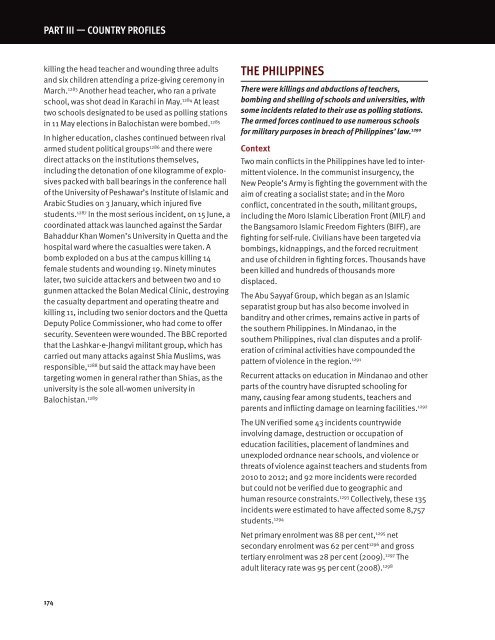Create successful ePaper yourself
Turn your PDF publications into a flip-book with our unique Google optimized e-Paper software.
PART III — COUNTRY PROFILeS<br />
killing the head teacher and wounding three adults<br />
and six children attending a prize-giving ceremony in<br />
March. 1283 Another head teacher, who ran a private<br />
school, was shot dead in Karachi in May. 1284 At least<br />
two schools designated to be used as polling stations<br />
in 11 May elections in Balochistan were bombed. 1285<br />
In higher education, clashes continued between rival<br />
armed student political groups 1286 and there were<br />
direct attacks on the institutions themselves,<br />
including the detonation of one kilogramme of explosives<br />
packed with ball bearings in the conference hall<br />
of the University of Peshawar’s Institute of Islamic and<br />
Arabic Studies on 3 January, which injured five<br />
students. 1287 In the most serious incident, on 15 June, a<br />
coordinated attack was launched against the Sardar<br />
Bahaddur Khan Women’s University in Quetta and the<br />
hospital ward where the casualties were taken. A<br />
bomb exploded on a bus at the campus killing 14<br />
female students and wounding 19. Ninety minutes<br />
later, two suicide attackers and between two and 10<br />
gunmen attacked the Bolan Medical Clinic, destroying<br />
the casualty department and operating theatre and<br />
killing 11, including two senior doctors and the Quetta<br />
Deputy Police Commissioner, who had come to offer<br />
security. Seventeen were wounded. The BBC reported<br />
that the Lashkar-e-Jhangvi militant group, which has<br />
carried out many attacks against Shia Muslims, was<br />
responsible, 1288 but said the attack may have been<br />
targeting women in general rather than Shias, as the<br />
university is the sole all-women university in<br />
Balochistan. 1289<br />
THe PHILIPPINeS<br />
There were killings and abductions of teachers,<br />
bombing and shelling of schools and universities, with<br />
some incidents related to their use as polling stations.<br />
The armed forces continued to use numerous schools<br />
for military purposes in breach of Philippines’ law. 1290<br />
Context<br />
Two main conflicts in the Philippines have led to intermittent<br />
violence. In the communist insurgency, the<br />
New People’s Army is fighting the government with the<br />
aim of creating a socialist state; and in the Moro<br />
conflict, concentrated in the south, militant groups,<br />
including the Moro Islamic Liberation Front (MILF) and<br />
the Bangsamoro Islamic Freedom Fighters (BIFF), are<br />
fighting for self-rule. Civilians have been targeted via<br />
bombings, kidnappings, and the forced recruitment<br />
and use of children in fighting forces. Thousands have<br />
been killed and hundreds of thousands more<br />
displaced.<br />
The Abu Sayyaf Group, which began as an Islamic<br />
separatist group but has also become involved in<br />
banditry and other crimes, remains active in parts of<br />
the southern Philippines. In Mindanao, in the<br />
southern Philippines, rival clan disputes and a proliferation<br />
of criminal activities have compounded the<br />
pattern of violence in the region. 1291<br />
Recurrent attacks on education in Mindanao and other<br />
parts of the country have disrupted schooling for<br />
many, causing fear among students, teachers and<br />
parents and inflicting damage on learning facilities. 1292<br />
The UN verified some 43 incidents countrywide<br />
involving damage, destruction or occupation of<br />
education facilities, placement of landmines and<br />
unexploded ordnance near schools, and violence or<br />
threats of violence against teachers and students from<br />
2010 to 2012; and 92 more incidents were recorded<br />
but could not be verified due to geographic and<br />
human resource constraints. 1293 Collectively, these 135<br />
incidents were estimated to have affected some 8,757<br />
students. 1294<br />
Net primary enrolment was 88 per cent, 1295 net<br />
secondary enrolment was 62 per cent 1296 and gross<br />
tertiary enrolment was 28 per cent (2009). 1297 The<br />
adult literacy rate was 95 per cent (2008). 1298<br />
174



